| Richard Marmo's SCALEWORLD |
Happy New Year, Happy 21st Century (this time it really is) and Happy New Milennium. Half of Arthur C. Clarke's famous book is now reality. It's 2001. And while his Space Odyssey is yet to occur, who knows what the next few years will bring. We can hope!
Hope springs eternal but as luck would have it, the year dawns with trouble for four separate websites that I'm involved with. So…I need to spend some time cleaning up the mess!
The four sites involved are: THE MODELER'S WEAPONS SHOP; SCALE PUBLICATIONS; MODEL BUILDING SERVICES BY RICHARD MARMO and B-36: SAVING THE LAST PEACEMAKER.
You've found the WEAPONS SHOP at it's original https://www.tricky.com/modeler/ site for several years. Tricky.com still exists but appears to now be strictly a personal page. No notification was given and there's no way of knowing how long the site has been gone. WEAPONS SHOP also had a second site at modelersweaponsshop.homepage.com. The other three sites were also on that host server. For whatever reason (I can only speculate here), two sites have disappeared completely and the other two are intermittently available. I've already received letters and emails from potential clients that either can't find the sites or can't get the links to work.
A solution is currently in the works, eventually placing each site on at least two other host servers. At the present time, they're only on one server and the B-36 site is on two. I'll let you know when they've been added to another server or two. The Homepage sites apparently still exist, somewhere, somehow. They're going to have to stay there because I can't gain access to either remove them or update them.
The NEW websites, along with correct email addresses, are as follows:
THE MODELER'S WEAPONS SHOP (1/32 & 1/48 resin castings):
modelersweaponsshop.freeyellow.com
tennexican@mindspring.com
SCALE PUBLICATIONS (Windows Wallpaper, aviation reference & how-to):
scalepublications.freeyellow.com
tennexican@mindspring.com
MODEL BUILDING SERVICES BY RICHARD MARMO (Professional model building services, from kit buildups to scratchbuilt commercial designs):
modelbuilder.freeyellow.com
tennexican@mindspring.com
B-36: SAVING THE LAST PEACEMAKER (Compact disc book by Ed Calvert, Don Pyeatt, Richard Marmo):
lastb-36.freeyellow.com
https://home.flash.net/~pye396/CDBook/
proweb@flash.net
If I asked you to name a USAF aircraft that was designed in the 1950s, had been in constant service for the last 40 years, was still in service today and is older than just about any pilot that flies her, what would you say? B-52? That'd certainly be a reasonable answer…and it'd be wrong. Or at least half wrong. While that does apply to the B-52, another aircraft falls in the same category…the Lockheed U-2. It's had ten major design changes and the end of it's service life is still not in sight.
There have been a number of U-2 kits produced over the decades, most of them in 1/48, starting with the HAWK kit that appeared in the late 60s. Of course, HAWK later became TESTORS and the U-2 kit continued to appear under that label.
 The latest release of a U-2 has come from ITALERI. To 1/48 scale, this version depicts the U-2R 'Senior Span' variant. So how does it differ from earlier U-2s? Well, you have the familiar mid-span long range tanks and the long nose that appeared a bit earlier. Most obvious is a large, elongated antenna housing mounted atop a pylon that's located on top of the fuselage. Purpose? Real time communications with satellites.
The latest release of a U-2 has come from ITALERI. To 1/48 scale, this version depicts the U-2R 'Senior Span' variant. So how does it differ from earlier U-2s? Well, you have the familiar mid-span long range tanks and the long nose that appeared a bit earlier. Most obvious is a large, elongated antenna housing mounted atop a pylon that's located on top of the fuselage. Purpose? Real time communications with satellites.
So what about the kit? You get some 124 nicely molded parts, all produced in black styrene (except for the three clear parts). Nothing is bagged, but you do get everything packed in a conventional top over bottom box. There's a small decal sheet and the usual international style instructions.
Surface detail is lightly raised and a molded fairing closes off the rear cockpit. Rear cockpit? That's what I said and there's a reason for it. This kit is a retool of an earlier 2-seat U-2 kit from ITALERI. However, things go even farther than that. What you're actually looking at is the ultimate stretch of a kit that first hit the market some 30-35 years ago. Yep, the HAWK U-2.
And frankly, I don't have a problem with it. The original HAWK kit was accurate and a very nice effort. Granted, there was no cockpit detail, but most of us didn't expect that in the late 60s. But this U-2R has progressed with the times and has a well done cockpit interior. Is it contest level? No, but that's what our model building skills are supposed to be for. Besides, maybe one of the aftermarket companies will produce a cockpit/detail set for it. The raised panel lines? Leave'em, sand'em off or rescribe everything. Your choice.
Bottom line? For $28.00, you get a very nice U-2R if all you do is build it straight from the box. Spend some time on it and you have a potential prize winner. What more could you ask?
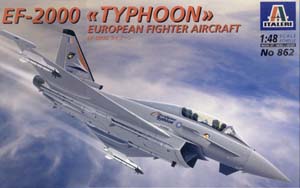 Those of you who like to stay on the cutting edge of aviation design by building models of aircraft that have yet to enter service will find another ITALERI effort of particular interest. Also to 1/48 scale, I'm talking about the Eurofighter EF-2000 Typhoon.
Those of you who like to stay on the cutting edge of aviation design by building models of aircraft that have yet to enter service will find another ITALERI effort of particular interest. Also to 1/48 scale, I'm talking about the Eurofighter EF-2000 Typhoon.
Designed by a collaberation of four Nations, the resulting design (which began in 1981) has a fascinating appearance. A delta-wing planform with canards mounted just about even with the windscreen. The large belly mounted intake is rectangular in form and the aircraft can be produced as a one or two seat design. It'll definitely get your attention. So will the model.
Packed inside a top over bottom box are 109 light gray and 6 clear parts. The clear parts have their own bag, but everything else doesn't. Instructions are the familiar ITALERI international style. You'll also find a large decal sheet that allows you to build the kit in either prototype markings or in the colors of any of the four Nations involved in it's development…England, Germany, Italy and Spain.
Surface detail is delicate and engraved. Parts breakdown appears to be completely conventional, so you should have little difficulty in construction. Remember I said that the actual aircraft could be produced as a one or two seater? This kit doesn't give you the option. It's a two-seater only, which means you get two cockpits. Interior detail is nicely done, including a couple of multi-part ejection seats. However (you knew there had to be one), ITALERI has opted for decals to replicate the instrument panels and consoles. The result is realistic but won't pass muster in a contest. Resin set anyone? Canopy is clear, though a bit on the thick side. It's also positionable, along with the spine mounted air brake.
Overall, a nice kit of an aircraft that'll be around for the next 20 or 30 years.
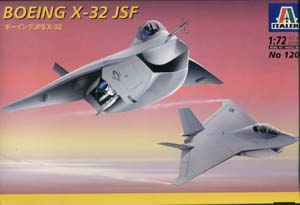 Speaking of an aircraft that'll be around for the next 20 or 30 years (actually 40+), consider one that hasn't even received a production contract yet…the JSF or Joint Strike Fighter. Right now it exists only as a pair of competing designs, the X-32 and X-35. Designed to replace the F-16, F/A-18, Harrier and Jaguar, these two X-planes would make an interesting addition to an experimental aircraft collection. And you can do it, at least in 1/72 scale.
Speaking of an aircraft that'll be around for the next 20 or 30 years (actually 40+), consider one that hasn't even received a production contract yet…the JSF or Joint Strike Fighter. Right now it exists only as a pair of competing designs, the X-32 and X-35. Designed to replace the F-16, F/A-18, Harrier and Jaguar, these two X-planes would make an interesting addition to an experimental aircraft collection. And you can do it, at least in 1/72 scale.
ITALERI has already released a kit of the X-32 (with an X-35 coming later). The X-32 is the Boeing effort and I'll guarantee you that the photos you've seen of it don't do it justice…or injustice. A stealth design, this little puppy tries to defy description. It has a more or less delta (or diamond) planform, outward canting twin verticals and a huge belly scoop mounted under the cockpit that makes this beast look a heckuva lot stubbier than it really is. Also keep in mind that a type of commonality rules here, so the versions produced for the various services/countries will look more or less the same but not exactly.
Anyhoo, the kit has some 50 light gray styrene parts, along with 3 clear. Instructions and a small prototype decal sheet complete the package. Everything is contained in a small end flap box (not my favorite design) and nothing is bagged. Once you take the shrink wrap off, be careful that the decals don't slip out of the flap and disappear on you.
Parts are crisply molded and all of the surface detail is lightly done and engraved. There's a proper throat for the intake, nicely detailed compressor blades and optional parts for the test booms if you choose to include them. Cockpit interior includes engraved detail on the instrument panel and consoles (no decals this time) and the canopy is positionable. You can also install the weapons bays open if you prefer.
This will build up into a delightful little model and the price is equally delightful. Only $14.00.
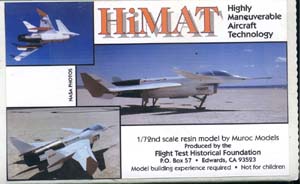 If you like a challenge, take a look at a resin kit from MUROC MODELS. Priced at $19.95 + $3.25 s&h and available from Flight Test Historical Foundation, P.O. Box 57, Edwards, CA 93523, this 1/72 scale kit of the HiMAT (Highly Maneuverable Aircraft Technology) test vehicle is essentially a scale model of a scale model. The real thing was only 20 feet long, which means the 1/72 version is a miniscule 3 1/2 inches long with a 3 inch wingspan. Considering the color scheme and the size of some of the components (Would you believe plastic rod that's only 25 thousandths of an inch in diameter?), this darn sure ain't gonna be a one-night project!
If you like a challenge, take a look at a resin kit from MUROC MODELS. Priced at $19.95 + $3.25 s&h and available from Flight Test Historical Foundation, P.O. Box 57, Edwards, CA 93523, this 1/72 scale kit of the HiMAT (Highly Maneuverable Aircraft Technology) test vehicle is essentially a scale model of a scale model. The real thing was only 20 feet long, which means the 1/72 version is a miniscule 3 1/2 inches long with a 3 inch wingspan. Considering the color scheme and the size of some of the components (Would you believe plastic rod that's only 25 thousandths of an inch in diameter?), this darn sure ain't gonna be a one-night project!
The kit comes packed in a very sturdy top flap box, complete with three color photos of the actual aircraft. Inside is a thorough set of instructions, a 4-view drawing to be used as painting and decal placement guide, an excellent set of decals and the model itself. Other than the decals, the model is actually the smallest item in the box. No worry about damaged parts because everything is enveloped in a sheet of bubble wrap.
Comprised of some 19 parts, your first reaction will be to reach for the Opti-Visor. That's due to the fact that around 90% of the model takes the form of a single casting. Specifically, the fuselage/wings. The rest of the parts will require the aforementioned Opti-Visor.
Quality is excellent with the fuselage/wings casting giving no indication at all of surface flaws or pinholes. There is a small amount of flash around the tailpipe and the sides of the fuselage near the canard locations. Remaining parts take the form of three separate groups, with the parts of each group being connected by very thin resin flash. Separating the parts shouldn't be a problem, but be sure to do it in an area where you won't run the risk of those little bitty pieces disappearing on you. It also wouldn't hurt to keep the tweezers handy.
The boxtop tells you that the kit requires modelbuilding experience. Believe it. It's small size alone means that there are no locators for the various parts, but that won't be a problem if you've had any kind of resin building experience. You also are given the option of building it with the gear up or down.
If you're looking for something different to add to your collection, this one certainly qualifies.
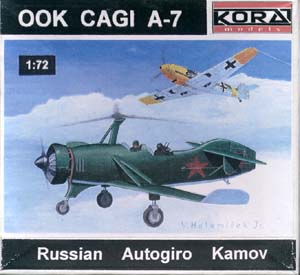 Even stranger…and utterly fascinating…is this 1/72 scale kit from a company in Eastern Europe called KORA MODELS. The subject in question is the Kamov A-7. If you've never heard of it, join the crowd. What you've just stumbled across is a combat autogyro that operated on the Russian front in WW-II. Until I ran across this kit, I didn't even know such an aircraft ever existed.
Even stranger…and utterly fascinating…is this 1/72 scale kit from a company in Eastern Europe called KORA MODELS. The subject in question is the Kamov A-7. If you've never heard of it, join the crowd. What you've just stumbled across is a combat autogyro that operated on the Russian front in WW-II. Until I ran across this kit, I didn't even know such an aircraft ever existed.
With two open cockpits (and the gunner in the back), a wing that was braced to the fuselage with struts, fixed tricycle gear w/wheel pants, single radial engine in the front and a three-blade rotor whirling merrily atop a slender mast, it was ungainly looking to say the least. Makes you wonder how many German pilots laughed themselves into hysterics whenever they spotted one.
However, consider that whenever a fixed-wing fighter and helicopter go head to head, the helicopter comes out on top because of it's superior maneuverability. Those German pilot's laughter might have been a bit short lived.
The one disadvantage to running across this kind of model is the fact that I have absolutely nothing in my reference collection on the Kamov A-7. If any of you have anything on it, I'd like to hear from you.
As for the model itself, it's not bad at all. You get some 31 resin and metal parts, a fret of photo etch, a few pieces of fine wire and a couple of instrument panel decals. No other markings are provided. Instructions are illustration style and adequate for the job.
Resin parts are clean with lightly engraved surface detail. There's very little flash on the main parts and what there is can be cleaned up easily. Smaller parts are attached to casting sprues. You'll have to take your time separating things in order to keep the smaller parts from winding up shorter than intended. This is fairly common in resin kits and can be overcome by removing the sprue from the part instead of the other way around.
There are no locating pins, though you will find small depressions indicating the location of such parts as the struts and braces. You may also want to consider replacing the resin engine with an injected version from the old parts box. Same comments may apply to the metal prop, though you need to find some decent reference photos first.
If you have some experience with resin kits and are looking for something that'll grab people's attention, this'un will do it. It's available from JOE'S MODELS, 19 Valley View Road, Verona, NJ 07044. His catalog lists quite a number of 'different' model subjects in both 1/72 and 1/48, so you might want to give him a call at 973-239-7682. Prefer to make contact by fax? That number's 973-571-9649. Price of the A-7 is $28.00 including s&h.
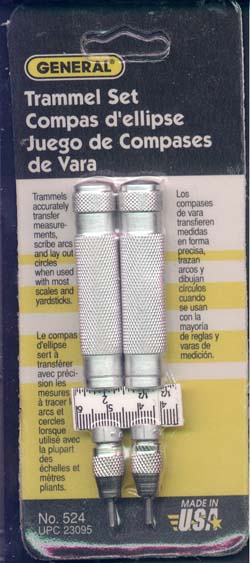 Looking for a way to lay out or cut circles and/or arcs? Most of the time we use a compass, but they have their drawbacks. For starters, the small drafting compasses may not have the capacity that we're looking for. Larger drafting compasses are on the expensive side. Other types of compasses don't have as much control. If the setting drifts, your layout winds up being either larger than intended or not a true circle.
Looking for a way to lay out or cut circles and/or arcs? Most of the time we use a compass, but they have their drawbacks. For starters, the small drafting compasses may not have the capacity that we're looking for. Larger drafting compasses are on the expensive side. Other types of compasses don't have as much control. If the setting drifts, your layout winds up being either larger than intended or not a true circle.
Consider, then, a little item that's available from GENERAL TOOLS… a Trammel Set. If you've never heard of Trammel Points, allow me to introduce you. They're essentially a pair of knurled cylinders. At one end of each, you'll find a chuck designed to hold either a sharp metal point or a pencil lead. Just above the chuck is a cutout that's designed to accept a metal ruler or scale, in this case one of the six-inch scales that GENERAL makes. Or you can use any other long bar or strip as long as you can make it fit. In fact, some Trammel Sets are designed to fit 2x4 lumber.
Simply make sure that the bar, ruler, scale or whatever you use is a bit longer than the radius of the circle you're drawing or scribing. Set the two Trammel Points in their appropriate positions on the scale, then have at it. The beauty of these things is that you can use both hands so there's no slippage and both scribe points remain perfectly vertical, eliminating unwanted beveled edges that are common with conventional compasses.
And the price ain't bad either. The set you see here sells for $15.88, very reasonable when you consider that…for all practical purposes…they'll last you a lifetime.
If you were fortunate enough to be on the receiving end of Christmas cash and are now flush with greenbacks, your primary interest is modern aircraft, ye olde reference shelf is somewhat lacking and you're looking for a place to spend the money, let me offer a suggestion.
I've already mentioned the NAVAL INSTITUTE PRESS catalog in a previous column. Now its time to turn our attention to a magnificent little tome that they publish.
 Specifically, THE NAVAL INSTITUTE GUIDE TO WORLD MILITARY AVIATION 1997-1998 by Renee J. Francillon. Wearing a $159.95 tag, it seems a bit pricy at first glance, but it isn't. Especially when compared to the asking price for Jane's All The World's Aircraft.
Specifically, THE NAVAL INSTITUTE GUIDE TO WORLD MILITARY AVIATION 1997-1998 by Renee J. Francillon. Wearing a $159.95 tag, it seems a bit pricy at first glance, but it isn't. Especially when compared to the asking price for Jane's All The World's Aircraft.
Utilizing an oversize format, you get 884 pages crammed into 9 1/2" x 12" hardcover bindings. And it's a solid 2" thick. Weight is somewhere around five pounds. So what do you get in return for crucifying a pair of C-notes? Let's take a look.
To begin with, you get a five-page listing of the contents, broken down into sections that include Nation, Aircraft by Manufacturer (followed by aircraft of the manufacturers), Indices and Addenda. Then there's four pages of Abbreviations and Acronyms, along with another two pages of NATO names.
From there you're into the meat of the book. The first section literally runs from A to Z (Afghanistan to Zimbabwe) and covers the Air Forces of the World. There are excellent photos of representative aircraft from each Nation, along with fascinating and useful statistics. You get basic national data, including the area, population, defense budget, size of the armed forces and more. Principal airbases and joint civil/military airfields are listed, including their names, coordinates, even the runway lengths. If that isn't enough, you are also provided with an aircraft census for each country that's broken down into fixed wing and helicopters. The lists range from very short for the poorest countries such as Chad (and there's no need to recount them) to voluminous for the United States.
Photos are b&w but are clear, numerous and frequently take up from 1/3 to 1/2 of a page. And some things show up that you don't expect. Such as a Grumman OV-1D Mohawk in Argentinian markings and sporting a Sharkmouth.
The second section deals with Military Aircraft of the World and also runs from A to Z (Aermacchi to Zlin). Information provided is extensive, including complete dimensions, weight, performance, payload, power plant(s), description of it's program history and more. When variants have been built under license, their designations and how they differ from the original design are provided.
You'll find frequent 3-views, though not for every aircraft, along with the occasional cutaway. It's amazing the number of light planes that are in military service in various countries. This includes aircraft you'd never think of in a military vein. Such as the Grumman Ag-Cat. Believe it or not, the Greek Air Force operates it as part of a Civil Service Assistance Squadron. The British have some powered gliders in service and you'll find some very good photos of the Antonov An-2 Colt biplane that was last built by PZL in Poland. Surprisingly, the aircraft is still in service in many countries, including the U.S.!! And it's not the only biplane. The Venuzuelan Air Force operates an aerobatic squadron that flys the Pitts S-2. I could go on, but you get the idea.
Nearing the back of the book, you'll find a two and a half page Index that lists Air Forces by Foreign Language Names, another three and a half pages listing Aircraft by Alternative Manufacturer's Names and Aircraft Manufacturers by Corporate Names cover still three more pages. Finally, a seven page Addenda updates the Air Forces of the World section and one more page takes care of the Military Aircraft of the World changes.
What more can I say? Buy it. You won't be sorry.
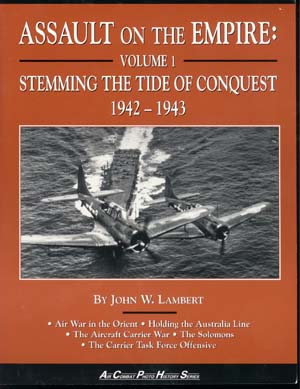 Latest addition to the Air Combat Photo History Series from SPECIALTY PRESS is ASSAULT ON THE EMPIRE, VOL. 1 by John Lambert. Price is $18.95.
Latest addition to the Air Combat Photo History Series from SPECIALTY PRESS is ASSAULT ON THE EMPIRE, VOL. 1 by John Lambert. Price is $18.95.
The focus of this volume is 1942-1943 and should get the attention of anyone who's interest lies in the Pacific Theatre. Coverage begins with the CBI and includes some very interesting shots of Flying Tigers aircraft. There's a couple of P-40Ks, one with a modified Sharkmouth and the other with a skull. And a nice shot of Miss-V, a P-38H with Dragon art that runs from the intakes all the way down the booms. From there, coverage takes you up thru Australia, the Solomons and the Southwest Pacific. A chapter on the carrier war includes many very interesting shots of Navy aircraft. One that'll get your attention is a Devastator with it's wings folded and already armed with a torpedo. It's sitting on an elevator, still several feet below the carrier deck. Between the way the photo is framed and all the detail that shows, it'd make an excellent subject for a diorama.
Coverage in this book ends with a chapter on the U.S. carrier offensive that began in mid-1943. By that time, the tide had turned and it was now a question of when victory would come, not if. You'll find a number of shots of the newer aircraft that were finally making their way into service. Hellcats and Avengers, for example. Also a couple of photos of both P-39s and P-40s taking off from carriers. P-39s??
Throughout the book you'll find photos of nose art, pilots and frames taken from gun camera film. All photos are in black and white, which is to be expected when you consider the time period and conditions.
Support your local hobby shop or order the book directly from Specialty Press, 11605 Kost Dam Road, North Branch, MN 55056 or call them at 800-895-4585. Keep in mind that there is a $4.50 shipping and handling charge per order.
Those of you in the United Kingdom can order from Airlife Publishing, 101 Longden Road, Shrewbury SY3 9EB, ENGLAND or call them at 01743 235651.
For the most part, we buy our books from hobby shops, mail order discounters and retail bookstores. If we're lucky, we find sales at 20% off and sometimes titles that we're after show up in the remainder bins for 30%, maybe 40% off. And once a title has been out for a few years…or even out of print…finding a copy takes on the appearance of a snipe hunt (if you don't know what a snipe hunt is, your life has been entirely too sheltered).
But there is an alternative. There's a chain of bookstores in the U.S. called HALF PRICE BOOKS. Believe me, if you haven't taken the time to browse thru one…go. And plan to spend some time there. Subjects run the gamut, including a substantial military/history section. You can find books on all eras, including but not limited to the Civil War (or War of the Rebellion), WW-1, WW-II and Viet Nam. Biographies, aircraft, armor, I could go on and on. Prices? Exactly what the name says; half of the retail price, sometimes less. And at the end of the year, they run a sale with an  additonal 20% off.
additonal 20% off.
Because they also buy books from individuals, there's no telling what you'll find. Titles change on a daily basis, so browsing frequently is the best way to track that elusive book you've been chasing for the last eight years.
If you're still thinking "Yeah, sure, but what do they have that I can use on my next model?", consider a couple of publications that I found.
First up is USAF COLORS & MARKINGS IN THE 1990s by Dana Bell. This softcover book is entirely in black and white, has no photos and is invaluable. Much of the material is drawn directly from Technical Order 1-1-4, which is then combined with many 3-view drawings from various government sources that are specifically used to show the color/camouflage patterns. You'll also find drawings that show the style and dimensions of letters and numbers. There's a list of unit codes, placard markings and locations, i.d. codes and markings for tubing, hoses and pipes, a glossary and a color listing by FS number that tells you what the color was used for.
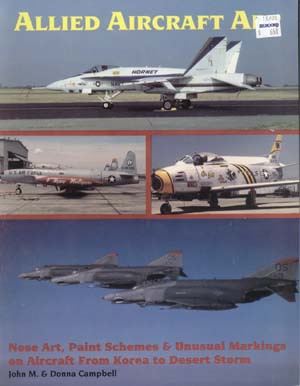 Then there's the piece de resistance, a page of 30 paint chip colors that are identified by FS numbers. Price at HALF PRICE BOOKS? A mere $9.98.
Then there's the piece de resistance, a page of 30 paint chip colors that are identified by FS numbers. Price at HALF PRICE BOOKS? A mere $9.98.
My second find? Another softcover book, this one titled ALLIED AIRCRAFT ART by John M. & Donna Campbell. As the description at the bottom of the cover tells you, it concentrates on Nose Art, Paint Schemes & Unusual Markings on Aircraft From Korea to Desert Storm.
Inside are 64 pages of art in glorious color, ranging from entire aircraft to tight shots of the art alone with a description of which aircraft carried it. Examples: An A-10A called Bavaria; an F-16A in Tiger Meet camouflage; an F-16A called Maloney's Pony; an A-7D called The City of Bowie, complete with a Bowie Knife under the name; a KC-135A called Arkansas Eagle and on and on and on. If that ain't enough, there's also art that adorned assorted pods and ordinance. And what did this little jewel set me back at HALF PRICE BOOKS? Would you believe $6.48?
Spend a couple of hours in one of their stores. It's worth it.
And that is it for this month. See you in February.








